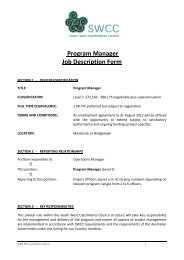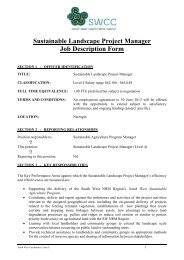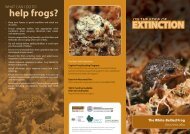Tender for the Programme - South West Catchments Council
Tender for the Programme - South West Catchments Council
Tender for the Programme - South West Catchments Council
Create successful ePaper yourself
Turn your PDF publications into a flip-book with our unique Google optimized e-Paper software.
DRAFT<br />
<strong>South</strong> <strong>West</strong> Regional NRM Strategy – Ancillary Document<br />
systematic; however, it did not necessarily encourage early stakeholder involvement. In <strong>the</strong> trials <strong>the</strong> Planning Key and its<br />
associated free software were found to be particularly useful in assisting with <strong>the</strong> development of Community Engagement<br />
Plans (CEPs). Especially useful was <strong>the</strong> CLIP (Collaboration, Conflict, Interest and Power) method <strong>for</strong> profiling stakeholders<br />
principally because it helped identify <strong>the</strong> engagement type (in<strong>for</strong>m, consult, involve, collaborate, empower) needed to meet <strong>the</strong><br />
different needs and expectations of stakeholders. However, future users of <strong>the</strong> Planning Key (Project Officers) should<br />
understand that <strong>the</strong>y still need to make decisions about which specific engagement tools (e.g. interviews, focus groups,<br />
workshops etc) <strong>the</strong>y will use in <strong>the</strong>ir engagements. The IAP2 spectrum (2006), which is an integral component of <strong>the</strong> Planning<br />
Key, can assist in identifying appropriate tools according to budgetary and/or o<strong>the</strong>r limiting factors. Importantly, <strong>the</strong> Planning<br />
Key also encouraged <strong>the</strong> development of evaluation strategies (to help determine <strong>the</strong> effectiveness of <strong>the</strong> engagement) and<br />
learning strategies (to help build human and institutional capital during <strong>the</strong> engagement), both of which are easily neglected<br />
during time-constrained projects as practitioners seek to meet broader project objectives. Future research with <strong>the</strong> Planing Key<br />
should consider how well <strong>the</strong> emergent CEPs align with or can be integrated into broader NRM project planning.<br />
Mincherton, G 2008 Buayanyup River Action Plan. Technical report prepared <strong>for</strong> Geographe<br />
Catchment <strong>Council</strong>, Busselton and Department of Water, Perth. 110pp.<br />
This action plan provides in<strong>for</strong>mation about <strong>the</strong> current health of <strong>the</strong> Buayanyup Catchment and recommendations on how to<br />
manage it better. The Pen-Scott Foreshore Condition Assessment Method was used to undertake assessments of <strong>the</strong><br />
<strong>for</strong>eshore with local landholders and community members and a summary of <strong>the</strong> <strong>for</strong>eshore condition ratings of <strong>the</strong> river is<br />
presented.<br />
NTNU 2012 New quantitative method enables researchers to assess environmental risks posed by nonnative<br />
species. The Norwegian University of Science and Technology in ScienceDaily. Retrieved Dec<br />
29, 2011, from http://www.sciencedaily.com/releases/2011/12/111226093008.htm<br />
Emerging technology: A coalition of researchers from <strong>the</strong> Norwegian University of Science and Technology (NTNU) and staff<br />
from <strong>the</strong> Norwegian Biodiversity In<strong>for</strong>mation Centre have created a unique quantitative method that enables researchers and<br />
o<strong>the</strong>rs to assess <strong>the</strong> environmental risks posed by non-native species (un<strong>for</strong>tunately currently only available in Norwegian, but<br />
planned <strong>for</strong> translation). While <strong>the</strong> method is tailored to <strong>the</strong> Norwegian environment, it can easily be adapted to o<strong>the</strong>r countries,<br />
and fills a vital need internationally <strong>for</strong> a quantifiable, uni<strong>for</strong>m approach to classifying and assessing alien species, <strong>the</strong><br />
developers say. "This provides an objective classification of <strong>the</strong>se species' potential impact on <strong>the</strong> Norwegian environment. We<br />
relied on much of <strong>the</strong> same principles as are used in <strong>the</strong> preparation of <strong>the</strong> 'Red List' of endangered and threatened species,"<br />
says Professor Bernt-Erik Sae<strong>the</strong>r at NTNU's Center <strong>for</strong> Conservation Biology (CCB), who has spearheaded <strong>the</strong> development of<br />
<strong>the</strong> new methodology along with a coalition of o<strong>the</strong>r Norwegian biologists and staff from <strong>the</strong> Biodiversity In<strong>for</strong>mation Centre.<br />
The method classifies species according to <strong>the</strong>ir reproductive ability, growth rate, individual densities, population densities,<br />
prevalence and <strong>the</strong>ir effect. This in<strong>for</strong>mation allows <strong>the</strong> researchers to plot <strong>the</strong> risks posed by each species on two axes, one<br />
which shows <strong>the</strong> likelihood of <strong>the</strong> species' dispersal and ability to establish itself in <strong>the</strong> environment (along with its rate of<br />
establishment, if applicable) and <strong>the</strong> o<strong>the</strong>r shows <strong>the</strong> degree to which <strong>the</strong> alien species will affect native species and habitats.<br />
Based on <strong>the</strong> combined values of <strong>the</strong> two axes, <strong>the</strong> species can be placed in one of five risk categories:<br />
Very high risk species that can have a strong negative effect on <strong>the</strong> Norwegian environment;<br />
High risk species that have spread widely with some ecological impact, or those that have a major ecological effect but have<br />
only limited distribution;<br />
Potentially high risk species that have very limited dispersal ability, but a substantial ecological impact or vice versa;<br />
Low risk species, with low or moderate dispersion and moderate to limited ecological effect;<br />
Species with no known risk factors that are not known to have spread and have no known ecological effects.<br />
Pen, LJ, HS Gill, P Humphries and IC Potter 1993 Biology of <strong>the</strong> black-stripe minnow Galaxiella<br />
nigrostriata, including comparisons with <strong>the</strong> o<strong>the</strong>r two Galaxiella species. J.Fish Biol. 43(6): 847-63.<br />
The growth, age composition, reproductive biology and diet of Galaxiella nigrostriata in seasonal water bodies in south-western<br />
Australia are described and compared with G. munda and G. pusilla. Like <strong>the</strong> o<strong>the</strong>r two Galaxiella species, G. nigrostriata has a<br />
1-year life cycle. The mean length attained by female G. nigrostriata at sexual maturity is approximately 37 mm, compared with<br />
about 47 and 28 mm <strong>for</strong> G. munda and G. pusilla, respectively. Like G. munda, G. nigrostriata is a multiple spawner. Although<br />
all three Galaxiella species breed mainly in winter and early spring, spawning occurs earlier in G. nigrostriata than in <strong>the</strong> o<strong>the</strong>r<br />
two species. An early production of offspring enables <strong>the</strong> young females and males of this species to reach approximately 78<br />
and 88%, respectively, of <strong>the</strong>ir ultimate body length by early summer. Such a prolonged period of early and relatively rapid<br />
growth is advantageous to G. nigrostriata, since this species lives in water bodies that often dry up during <strong>the</strong> summer and early<br />
autumn and thus cannot grow during this period. The gonads start to undergo rapid development in autumn, when <strong>the</strong> pools<br />
begin to fill with water following <strong>the</strong> onset of <strong>the</strong> seasonal rains. All three Galaxiella species are carnivores. Galaxiella<br />
nigrostriata mainly takes prey from <strong>the</strong> water column and <strong>the</strong> water surface, G. pusilla focuses on prey in <strong>the</strong> water column and<br />
benthos, and G. munda feeds widely on prey on <strong>the</strong> water surface, throughout <strong>the</strong> water column and from <strong>the</strong> benthos. The<br />
prevalence of small prey, such as cladocera and calanoid copepods, is greater in <strong>the</strong> diets of G. nigrostriata and G. pusilla than<br />
in that of G. munda. Electronic version not available.<br />
PHCC 2005 Peel-Harvey Catchment natural resource management plan. Prepared by Land<br />
Assessment Pty Ltd <strong>for</strong> <strong>the</strong> Peel-Harvey Catchment <strong>Council</strong> (PHCC), Mandurah, WA. 114 pp.<br />
Key strategy produced by one of six sub-regional catchment management groups, listing key assets, threats and priority actions<br />
to address <strong>the</strong>se. Resources (assets) are discussed under <strong>the</strong> headings land resources, water resources, biodiversity, coastal<br />
environment, marine environment, air, climate, and people & culture. Importantly, only issues (threats) and appropriate actions<br />
15






